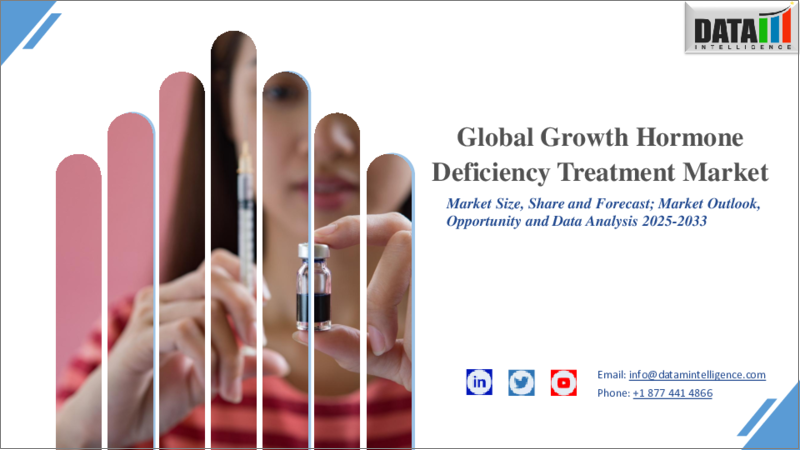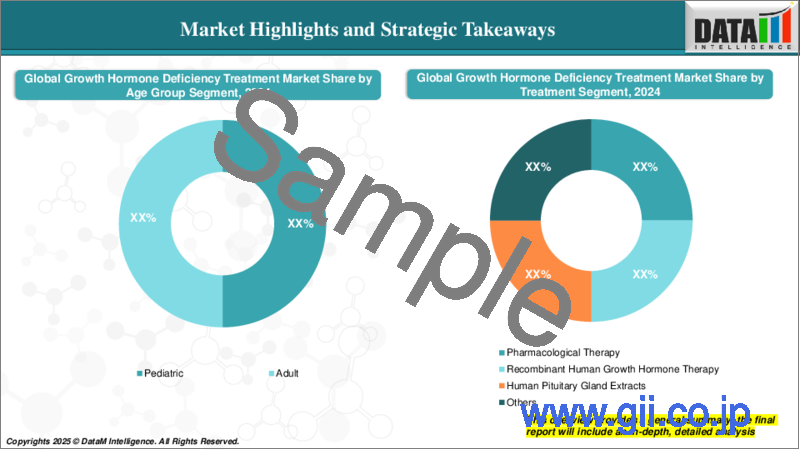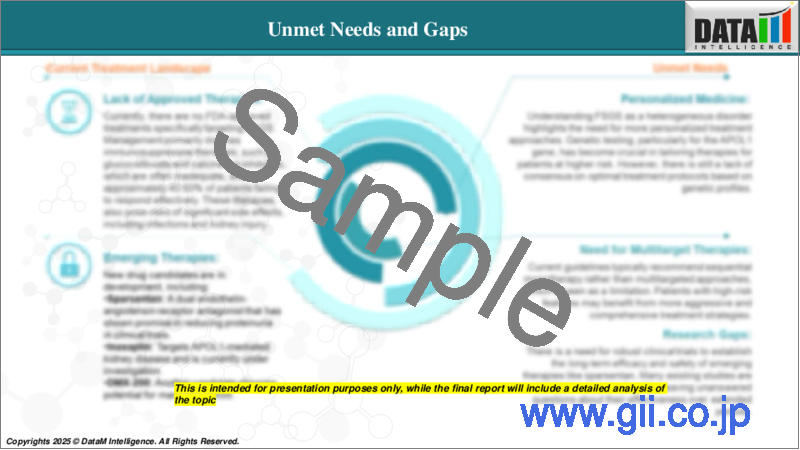|
|
市場調査レポート
商品コード
1634221
成長ホルモン欠乏症治療の世界市場 - 2024年~2032年Global Growth Hormone Deficiency Treatment Market - 2024 - 2032 |
||||||
カスタマイズ可能
適宜更新あり
|
|||||||
| 成長ホルモン欠乏症治療の世界市場 - 2024年~2032年 |
|
出版日: 2025年01月13日
発行: DataM Intelligence
ページ情報: 英文 176 Pages
納期: 即日から翌営業日
|
- 全表示
- 概要
- 目次
世界の成長ホルモン欠乏症治療市場は、2024年に69億米ドルに達し、2032年には92億米ドルに達すると予測され、予測期間2024年から2032年までのCAGRは12.1%で成長しますとする。
成長ホルモン欠乏症(GHD)は、下垂体前葉からの成長ホルモン(GH)の分泌不全によって引き起こされる疾患です。成長ホルモン欠乏症は、遺伝的変異や下垂体の損傷によっても発症します。
市場力学:
促進要因と抑制要因
革新的ソリューションの開発の増加
革新的ソリューションの開発の高まりが、成長ホルモン欠乏症治療市場を牽引すると予想されます。革新的なソリューション開発の高まりは、成長ホルモン欠乏症(GHD)市場の成長を促進する主要因です。より効果的な新しい治療法は、スマートペンのような優れたデリバリーシステムなどの進歩により、患者の利便性とアドヒアランスを向上させ、GHDの管理を改善しています。さらに、成長ホルモン治療における継続的な技術革新は、小児および成人患者、成人発症成長ホルモン欠乏症などの疾患を含む、新たな規制当局の承認と治療適応の拡大を推進しています。例えば、ノボノルディスクは2023年4月、ソグロヤ(ソマパシタンベコ)注射液5mg、10mg、15mgについて、内因性成長ホルモンの分泌不全による成長不全を有する2歳半以上の小児に対する治療という新たな適応症の承認を米国食品医薬品局(FDA)から取得しました。この新しい適応症により、ソグローヤは小児および成人に対する初めての、そして唯一の週1回投与の成長ホルモン(GH)治療薬となります。
新たな製剤によるソリューションの開発は、市場全体の牽引役となり貢献するものと期待されます。こうした治療選択肢の拡大は患者層を拡大し、市場の成長に寄与します。
成長ホルモン欠乏症治療に関連する合併症
成長ホルモン欠乏症治療に関連する合併症や副作用は、市場全体の成長を妨げると予想されます。これは治療に伴う副作用の結果によるものです。一般的な副作用には、関節痛、筋肉不快感、浮腫などがあり、患者の不満足や治療中止の原因となります。その結果、成長ホルモン欠乏症患者のために製造されている医薬品や製品の使用量が減少する可能性があります。
目次
第1章 調査手法と調査範囲
第2章 定義と概要
第3章 エグゼクティブサマリー
第4章 市場力学
- 影響要因
- 促進要因
- 革新的なソリューションの開発の増加
- 抑制要因
- 成長ホルモン欠乏症治療に関連する合併症
- 機会
- 影響分析
- 促進要因
第5章 産業分析
- ポーターのファイブフォース分析
- サプライチェーン分析
- 価格分析
- 特許分析
- 規制分析
- SWOT分析
- アンメットニーズ
第6章 タイプ別
- 小児
- 成人
第7章 治療別
- 薬物療法
- 組み換えヒト成長ホルモン療法
- ヒト下垂体抽出物
- その他
第8章 投与経路別
- 静脈内
- 筋肉内
- その他
第9章 流通チャネル別
- 病院薬局
- オンライン薬局
- 小売薬局
第10章 地域別
- 北米
- 米国
- カナダ
- メキシコ
- 欧州
- ドイツ
- 英国
- フランス
- スペイン
- イタリア
- その他欧州地域
- 南米
- ブラジル
- アルゼンチン
- その他南米
- アジア太平洋地域
- 中国
- インド
- 日本
- 韓国
- その他アジア太平洋地域
- 中東・アフリカ
第11章 競合情勢
- 競合シナリオ
- 市況・シェア分析
- M&A分析
第12章 企業プロファイル
- Pfizer Inc.
- 会社概要
- 製品ポートフォリオ
- 製品説明
- 製品の主要業績評価指標(KPI)
- 過去および予測の製品販売
- 製品販売量
- 財務概要
- 会社の収益
- 地域別収益分配
- 収益予測
- 主な発展
- 合併と買収
- 主な製品開発活動
- 規制当局の承認等
- SWOT分析
- Sandoz AG
- Novo Nordisk Inc.
- Eli Lilly and Company
- Ferring
- Genentech, Inc.
- Merck KGaA(EMD Serono, Inc.)
- Reliance Life Sciences
- AnkeBio Co., Ltd
- Omicron Pharma
- Similar data will be provided for each market player.
- Genexine, Inc.
- パイプライン製品の説明
- 製品の主要業績評価指標(KPI)
- 主な活動
- 市場参入のタイムライン
- 製品普及率
- 売上予測と予測
- JCR Pharmaceuticals Co., Ltd.
- Ascendis Pharma
- BioNTech SE.
- Philogen S.p.A.
- 各市場参入企業に対しても同様のデータが提供されます。
第13章 付録
The global growth hormone deficiency treatment market reached US$ 6.9 billion in 2024 and is expected to reach US$ 9.2 billion by 2032, growing at a CAGR of 12.1% during the forecast period 2024-2032.
Growth hormone deficiency (GHD) is a condition caused by the inadequate secretion of growth hormone (GH) from the anterior pituitary gland.. Growth hormone deficiency can occur due to genetic mutation and even due to the result of the pituitary gland damage.
Market Dynamics: Drivers & Restraints
Increasing development of innovative solutions
The rising development of innovative solutions is expected to drive the growth hormone deficiency treatment market. The growing development of innovative solutions is a key factor driving the growth of the growth hormone deficiency (GHD) market. New, more effective treatments are improving the management of GHD, with advancements such as better delivery systems like smart pens, which increase patient convenience and adherence. Moreover, the continuous innovation in growth hormone treatments is driving new regulatory approvals and expanding treatment indications, including for pediatric and adult patients and those with conditions like adult-onset growth hormone deficiency. For instance, in April 2023, Novo Nordisk received the U.S. Food and Drug Administration (FDA) approval for a new indication for Sogroya (somapacitan-beco) injection 5 mg, 10 mg, or 15 mg for the treatment of children aged 2.5 years and older who have growth failure due to inadequate secretion of endogenous growth hormone. With this new indication, Sogroya becomes the first and only once-weekly growth hormone (GH) treatment for children and adults.
Developing solutions with new formulations is expected to gain traction and contribute to the overall market. This expansion of treatment options broadens the patient population and contributes to the market's growth.
Complications associated with the growth hormone deficiency treatment
The complications and side effects associated with the growth hormone deficiency treatment are expected to hamper the overall market growth. This is due to the result of adverse reactions proceeding with the treatment. Common adverse effects include joint pain, muscle discomfort, and edema, which can lead to patient dissatisfaction and discontinuation of therapy. This could result in the reduced usage of the drugs and products that are being manufactured for growth hormone deficiency patients.
Segment Analysis
The global growth hormone deficiency treatment market is segmented based on type, treatment, route of administration, distribution channel, and region.
Type:
Pharmacological therapy segment is expected to dominate the global growth hormone deficiency treatment market share
The pharmacological therapy segment is expected to hold a major portion of the growth hormone deficiency market due to its proven effectiveness and widespread use. Recombinant growth hormone (rGH) therapies have long been the gold standard for treating GHD, providing significant benefits in terms of growth stimulation, improved bone density, and overall metabolic function.
Advances in drug formulations, such as long-acting growth hormone treatments and improved delivery systems like needle-free injectors and smart pens, have made these therapies more convenient and patient-friendly, further driving their adoption. For instance, in June 2023, Pfizer Inc. and OPKO Health Inc. received the U.S. Food and Drug Administration (FDA) approval for its NGENLA (somatrogon-ghla), a once-weekly, human growth hormone analog indicated for the treatment of pediatric patients aged three years and older who have growth failure due to inadequate secretion of endogenous growth hormone.
Additionally, the introduction of biosimilars, which are more affordable alternatives to branded rGH products, is expanding access to treatment and increasing market penetration. As the number of GHD diagnoses continues to rise globally, the demand for pharmacological treatments remains strong, with continuous innovation leading to new regulatory approvals and expanded indications. These factors position the pharmacological therapy segment to maintain its dominance in the market, meeting the growing demand for effective GHD management.
Geographical Analysis
North America is expected to hold a significant position in the global growth hormone deficiency treatment market share
North America is expected to hold a dominant position in the global growth hormone deficiency market due to several significant factors. The region benefits from high awareness of GHD, advanced diagnostic technologies, and well-established healthcare infrastructure, which leads to early diagnosis and prompt treatment. North American patients have greater access to cutting-edge growth hormone therapies, such as recombinant growth hormone and long-acting formulations, ensuring effective treatment options.
Additionally, the presence of leading pharmaceutical companies and research institutions in the U.S. drives innovation and continuous development of new treatment options. Thus, the above factors position North America to maintain a dominant share of the global GHD treatment market.
Competitive Landscape
The major global players in the growth hormone deficiency treatment market include Pfizer Inc., Sandoz AG, Novo Nordisk Inc., Eli Lilly and Company, Ferring, Genentech, Inc., Merck KGaA (EMD Serono, Inc.), Reliance Life Sciences, AnkeBio Co., Ltd and Omicron Pharma among others.
Key Developments
- In December 2023, Ascendis Pharma A/S announced positive topline results from foresiGHt, its Phase 3 randomized, parallel-arm, placebo-controlled (double-blind) and active-controlled (open-label) trial to compare the efficacy and safety of TransCon hGH (lonapegsomatropin) with placebo and daily hGH (human growth hormone, somatropin) in adults with growth hormone deficiency (GHD).
Why Purchase the Report?
- Pipeline & Innovations: Reviews ongoing clinical trials, and product pipelines, and forecasts upcoming advancements in medical devices and pharmaceuticals.
- Product Performance & Market Positioning: Analyzes product performance, market positioning, and growth potential to optimize strategies.
- Real-World Evidence: Integrates patient feedback and data into product development for improved outcomes.
- Physician Preferences & Health System Impact: Examines healthcare provider behaviors and the impact of health system mergers on adoption strategies.
- Market Updates & Industry Changes: Covers recent regulatory changes, new policies, and emerging technologies.
- Competitive Strategies: Analyzes competitor strategies, market share, and emerging players.
- Pricing & Market Access: Reviews pricing models, reimbursement trends, and market access strategies.
- Market Entry & Expansion: Identifies optimal strategies for entering new markets and partnerships.
- Regional Growth & Investment: Highlights high-growth regions and investment opportunities.
- Supply Chain Optimization: Assesses supply chain risks and distribution strategies for efficient product delivery.
- Sustainability & Regulatory Impact: Focuses on eco-friendly practices and evolving regulations in healthcare.
- Post-market Surveillance: Uses post-market data to enhance product safety and access.
- Pharmacoeconomics & Value-Based Pricing: Analyzes the shift to value-based pricing and data-driven decision-making in R&D.
The Global Growth Hormone Deficiency Treatment Market report delivers a detailed analysis with 60+ key tables, more than 50 visually impactful figures, and 176 pages of expert insights, providing a complete view of the market landscape.
Target Audience 2023
- Manufacturers: Pharmaceutical, Medical Device, Biotech Companies, Contract Manufacturers, Distributors, Hospitals.
- Regulatory & Policy: Compliance Officers, Government, Health Economists, Market Access Specialists.
- Technology & Innovation: AI/Robotics Providers, R&D Professionals, Clinical Trial Managers, Pharmacovigilance Experts.
- Investors: Healthcare Investors, Venture Fund Investors, Pharma Marketing & Sales.
- Consulting & Advisory: Healthcare Consultants, Industry Associations, Analysts.
- Supply Chain: Distribution and Supply Chain Managers.
- Consumers & Advocacy: Patients, Advocacy Groups, Insurance Companies.
- Academic & Research: Academic Institutions.
Table of Contents
1. Methodology and Scope
- 1.1. Research Methodology
- 1.2. Research Objective and Scope of the Report
2. Definition and Overview
3. Executive Summary
- 3.1. Snippet by Type
- 3.2. Snippet by Application
- 3.3. Snippet by End-User
- 3.4. Snippet by Region
4. Dynamics
- 4.1. Impacting Factors
- 4.1.1. Drivers
- 4.1.1.1. Increasing development of innovative solutions
- 4.1.2. Restraints
- 4.1.2.1. Complications associated with the growth hormone deficiency treatment
- 4.1.3. Opportunity
- 4.1.4. Impact Analysis
- 4.1.1. Drivers
5. Industry Analysis
- 5.1. Porter's Five Force Analysis
- 5.2. Supply Chain Analysis
- 5.3. Pricing Analysis
- 5.4. Patent Analysis
- 5.5. Regulatory Analysis
- 5.6. SWOT Analysis
- 5.7. Unmet Needs
6. By Type
- 6.1. Introduction
- 6.1.1. Analysis and Y-o-Y Growth Analysis (%), By Type
- 6.1.2. Market Attractiveness Index, By Type
- 6.2. Pediatric*
- 6.2.1. Introduction
- 6.2.2. Market Size Analysis and Y-o-Y Growth Analysis (%)
- 6.3. Adult
7. By Treatment
- 7.1.1. Introduction
- 7.1.1.1. Market Size Analysis and Y-o-Y Growth Analysis (%), By Treatment
- 7.1.1.2. Market Attractiveness Index, By Treatment
- 7.1.2. Pharmacological Therapy*
- 7.1.2.1. Introduction
- 7.1.2.2. Market Size Analysis and Y-o-Y Growth Analysis (%)
- 7.1.3. Recombinant Human Growth Hormone Therapy
- 7.1.4. Human Pituitary Gland Extracts
- 7.1.5. Others
8. By Route of Administration
- 8.1. Introduction
- 8.1.1. Market Size Analysis and Y-o-Y Growth Analysis (%), By Route of Administration
- 8.1.2. Market Attractiveness Index, By Route of Administration
- 8.2. Intravenous*
- 8.2.1. Introduction
- 8.2.2. Market Size Analysis and Y-o-Y Growth Analysis (%)
- 8.3. Intramuscular
- 8.4. Others
9. By Distribution Channel
- 9.1. Introduction
- 9.1.1. Market Size Analysis and Y-o-Y Growth Analysis (%), By Distribution Channel
- 9.1.2. Market Attractiveness Index, By Distribution Channel
- 9.2. Hospital Pharmacy*
- 9.2.1. Introduction
- 9.2.2. Market Size Analysis and Y-o-Y Growth Analysis (%)
- 9.3. Online Pharmacy
- 9.4. Retail Pharmacy
10. By Region
- 10.1. Introduction
- 10.1.1. Market Size Analysis and Y-o-Y Growth Analysis (%), By Region
- 10.1.2. Market Attractiveness Index, By Region
- 10.2. North America
- 10.2.1. Introduction
- 10.2.2. Key Region-Specific Dynamics
- 10.2.3. Market Size Analysis and Y-o-Y Growth Analysis (%), By Type
- 10.2.4. Market Size Analysis and Y-o-Y Growth Analysis (%), By Treatment
- 10.2.5. Market Size Analysis and Y-o-Y Growth Analysis (%), By Route of Administration
- 10.2.6. Market Size Analysis and Y-o-Y Growth Analysis (%), By Distribution Channel
- 10.2.7. Market Size Analysis and Y-o-Y Growth Analysis (%), By Country
- 10.2.7.1. U.S.
- 10.2.7.2. Canada
- 10.2.7.3. Mexico
- 10.3. Europe
- 10.3.1. Introduction
- 10.3.2. Key Region-Specific Dynamics
- 10.3.3. Market Size Analysis and Y-o-Y Growth Analysis (%), By Type
- 10.3.4. Market Size Analysis and Y-o-Y Growth Analysis (%), By Treatment
- 10.3.5. Market Size Analysis and Y-o-Y Growth Analysis (%), By Route of Administration
- 10.3.6. Market Size Analysis and Y-o-Y Growth Analysis (%), By Distribution Channel
- 10.3.7. Market Size Analysis and Y-o-Y Growth Analysis (%), By Country
- 10.3.7.1. Germany
- 10.3.7.2. U.K.
- 10.3.7.3. France
- 10.3.7.4. Spain
- 10.3.7.5. Italy
- 10.3.7.6. Rest of Europe
- 10.4. South America
- 10.4.1. Introduction
- 10.4.2. Key Region-Specific Dynamics
- 10.4.3. Market Size Analysis and Y-o-Y Growth Analysis (%), By Type
- 10.4.4. Market Size Analysis and Y-o-Y Growth Analysis (%), By Treatment
- 10.4.5. Market Size Analysis and Y-o-Y Growth Analysis (%), By Route of Administration
- 10.4.6. Market Size Analysis and Y-o-Y Growth Analysis (%), By Distribution Channel
- 10.4.7. Market Size Analysis and Y-o-Y Growth Analysis (%), By Country
- 10.4.7.1. Brazil
- 10.4.7.2. Argentina
- 10.4.7.3. Rest of South America
- 10.5. Asia-Pacific
- 10.5.1. Introduction
- 10.5.2. Key Region-Specific Dynamics
- 10.5.3. Market Size Analysis and Y-o-Y Growth Analysis (%), By Type
- 10.5.4. Market Size Analysis and Y-o-Y Growth Analysis (%), By Treatment
- 10.5.5. Market Size Analysis and Y-o-Y Growth Analysis (%), By Route of Administration
- 10.5.6. Market Size Analysis and Y-o-Y Growth Analysis (%), By Distribution Channel
- 10.5.7. Market Size Analysis and Y-o-Y Growth Analysis (%), By Country
- 10.5.7.1. China
- 10.5.7.2. India
- 10.5.7.3. Japan
- 10.5.7.4. South Korea
- 10.5.7.5. Rest of Asia-Pacific
- 10.6. Middle East and Africa
- 10.6.1. Introduction
- 10.6.2. Key Region-Specific Dynamics
- 10.6.3. Market Size Analysis and Y-o-Y Growth Analysis (%), By Type
- 10.6.4. Market Size Analysis and Y-o-Y Growth Analysis (%), By Treatment
- 10.6.5. Market Size Analysis and Y-o-Y Growth Analysis (%), By Route of Administration
- 10.6.6. Market Size Analysis and Y-o-Y Growth Analysis (%), By Distribution Channel
11. Competitive Landscape
- 11.1. Competitive Scenario
- 11.2. Market Positioning/Share Analysis
- 11.3. Mergers and Acquisitions Analysis
12. Company Profiles
Key Market Players
- 12.1. Pfizer Inc.*
- 12.1.1. Company Overview
- 12.1.2. Product Portfolio
- 12.1.2.1. Product Description
- 12.1.2.2. Product Key Performance Indicators (KPIs)
- 12.1.2.3. Historic and Forecasted Product Sales
- 12.1.2.4. Product Sales Volume
- 12.1.3. Financial Overview
- 12.1.3.1. Company Revenue's
- 12.1.3.2. Geographical Revenue Shares
- 12.1.3.3. Revenue Forecasts
- 12.1.4. Key Developments
- 12.1.4.1. Mergers & Acquisitions
- 12.1.4.2. Key Product Development Activities
- 12.1.4.3. Regulatory Approvals etc.
- 12.1.5. SWOT Analysis
- 12.2. Sandoz AG
- 12.3. Novo Nordisk Inc.
- 12.4. Eli Lilly and Company
- 12.5. Ferring
- 12.6. Genentech, Inc.
- 12.7. Merck KGaA (EMD Serono, Inc.)
- 12.8. Reliance Life Sciences
- 12.9. AnkeBio Co., Ltd
- 12.10. Omicron Pharma
- Similar data will be provided for each market player.
Emerging Market Players
- 12.11. Genexine, Inc.*
- 12.11.1. Pipeline Products Description
- 12.11.2. Product Key Performance Indicators (KPIs)
- 12.11.3. Key Activities
- 12.11.4. Market Entry Timelines
- 12.11.5. Product Penetration Rate
- 12.11.6. Sales Estimation and Projections
- 12.12. JCR Pharmaceuticals Co., Ltd.
- 12.13. Ascendis Pharma
- 12.14. BioNTech SE.
- 12.15. Philogen S.p.A.
- Similar data will be provided for each market player.
LIST NOT EXHAUSTIVE
13. Appendix
- 13.1. About Us and Services
- 13.2. Contact Us






